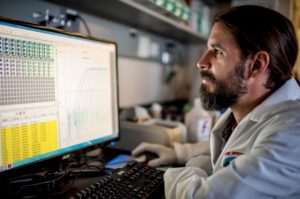If binging on Netflix sounds more appealing than going to the gym, consider this: scientists are finding that cardiovascular exercise is having positive effects on the human gut microbiome — the community of trillions of tiny organisms that thrive inside the dark, wet, warm walls of our intestines. That is important because research is linking poor gut health to a whole host of ailments and conditions including cancer, Alzheimer’s disease, obesity, asthma and autism.
“Most of the microbes living in and on our bodies are bacteria that have a positive impact on our health,” said Greg Caporaso, director of the Microbiome Center at The Pathogen and Microbiome Institute at Northern Arizona University. “We’re at the point now where we’re starting to understand the relationships between our gut microbiome and our health. We know that these microbes help us in many ways. For example, they help train our immune system, they help us digest food and we know that when there is some bad configuration, something we would call a dysbiosis, it can have far-reaching negative impacts on our health. It can be associated with things like inflammatory bowel disease, it can make us more likely to develop colon cancer, it can even impact our behavior by affecting the brain through a few different pathways. So now that we understand that these microbial communities impact our health, one of the next things we are interested in is understanding how we might be able to change these communities to improve our health.”
The makeup of our individual microbiome, says Caporaso, really starts at birth. There are differences in the microbiome composition of babies who were born via C-section compared to those delivered vaginally. And breast-fed babies have a different microbiome. Throughout the first few years of life, the microbes we are exposed to in all kinds of different environments develop the microbiome. And it can change depending on what we eat, whether we have a pet and if we take antibiotics. Exercise is also getting a lot of attention lately as a way to alter the human microbiome.
“One early study looked at elite athletes and compared those with sedentary individuals. It showed that there were compositional differences in the gut microbiome between those individuals,” said Caporaso. “The specific types of changes include an increase in the diversity in the microbiome, or the number of different types of species that were living in the gut. In many cases, lower diversity may be associated with a less healthy or disease state. While not always true, higher diversity is usually associated with better health.”
Working with the NAU Health Sciences Fitness Assessment and Sport Training Lab, Caporaso and others at The Pathogen and Microbiome Institute are conducting a study to measure how the diversity of the microbiome changes with changes to an individual’s level of physical activity.
NAU exercise physiologist Dierdra Bycura recently put 36 college students through an eight-week training course – three, hour-long exercise sessions a week – that involved indoor cycling, jogging on a treadmill, step aerobics classes and circuit training. Researchers took samples of the gut microbiome of the exercising volunteers at regular intervals throughout the two-month experiment.
“Cardio-respiratory fitness appears to be positively correlated with increased levels of short-chain fatty acids and better microbial diversity improving gut health,” says Bycura. “Short-chain fatty acids serve as an energy source for a variety of tissues, most notably, they increase insulin sensitivity in the skeletal muscle and reduce markers of inflammation. This has important implications for overall health and possible use of exercise is a means for improving gut health in persons with health challenges, such as diabetes, and autoimmune diseases like lupus and allergies.”
But, she notes, when exercise stops, the microbiome reverts back to what it was before the training began.
Studies examining the microbiome have increased because the cost of DNA sequencing, the primary technology for generating data on the human microbiome, has decreased and bioinformatics has made it easier to understand the results. “Bioinformatics is an area of study that combines biology and computer science. The microbiome analysis software QIIME, developed by Greg and his colleagues, wraps multiple tools together to do a thorough statistical analysis with the data.”
Scientists have been aware of the human microbiome for hundreds of years, but advances in DNA sequencing in the last decade or so have vastly increased the ability to study microscopic organisms without having to grow them in a Petri dish. “A lot of our recent advances have been driven by improvements in our ability to sequence microbial DNA and use bioinformatics to analyze that DNA,” said Caporaso. “We are only aware of the existence of the majority of microbes on Earth because we’ve observed their DNA sequences, so DNA sequencing is an essential technology for studying microbiomes.”
The researchers expect to have the results of their cardiovascular experiment this summer. “Microbiome studies reinforce what we already know: keeping active throughout our lives is an important part of being healthy and that includes physically, mentally and even microbially,” explained Caporaso.
The researchers are getting ready to study the impact of high-intensity, interval training like CrossFit on the human gut microbiome. They also want to know what changes happen through yoga and meditation. FBN
By Bonnie Stevens, FBN
Photo captions:
Biologist Greg Caporaso uses his microbiome analysis software known as QUIIME to study changes in the bacteria of the human gut.
Courtesy photo








